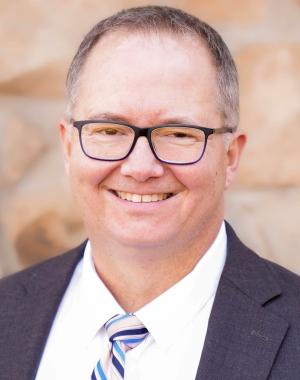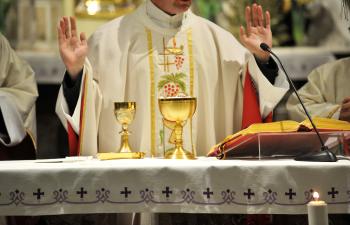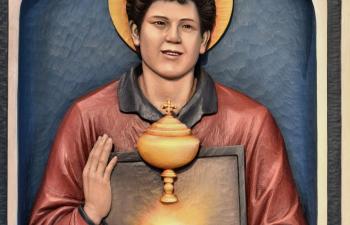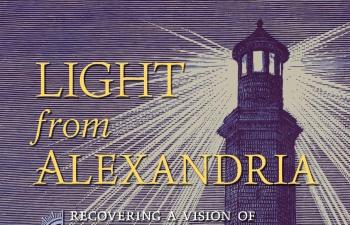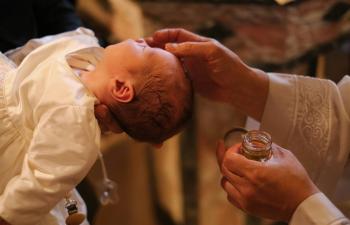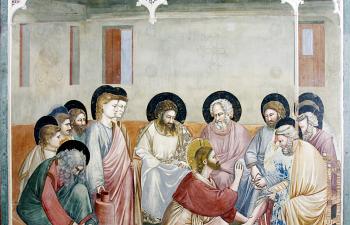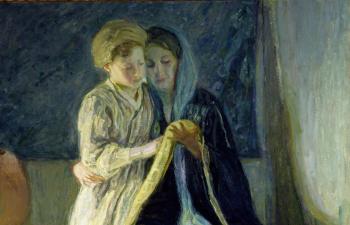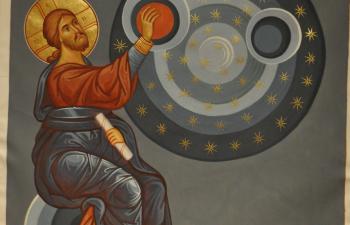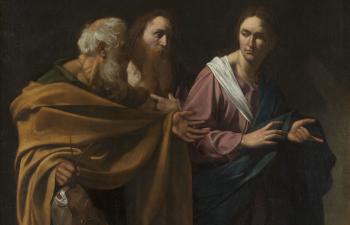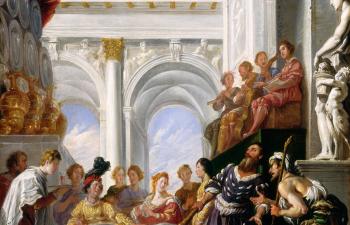Beneath the Basilica of the Annunciation in Nazareth is the place where tradition tells us the Angel appeared to the Blessed Virgin Mary. An altar stands in this grotto, inscribed with these words: “verbum caro hic factum est” (the Word became flesh here).
The Incarnation of God’s Son into human flesh is not a myth or fairy tale. It is an historical event that happened in a specific year, in an actual village we can locate on a map, within a particular home and family.
Numerous consequences flow from this wondrous fact of God’s Son taking upon himself our human condition. Let’s consider two important ones.
First, the Incarnation not only shows us that God saves us, but it also reveals how he saves us. In his infinite wisdom and love, he has chosen to redeem us in a way perfectly tailored to our human nature, fashioned as we are of both a spiritual soul and a human body. In Nazareth and then Bethlehem, God becomes encounterable not merely in a spiritual way but with our eyes and our ears and our hands—because the Second Person of the Blessed Trinity can be seen and heard and touched.
From these events, we see that God’s saving plan is incarnational. He tangibly communicates his Word and his grace to us, in ways profoundly aligned with our human senses.
But this incarnational way presents real challenges too. Have you ever heard the question—or asked it yourself—why it is necessary to go to a priest to have our sins forgiven? Or how is it possible that what appears to be bread and wine are actually something entirely different? The problem we run into is that we do not expect the things of God to appear ordinary, mundane, human, and earthy. Yet, this is exactly how the waters of Baptism or the Eucharistic elements could be described. It is important to see that this methodology God employs in the sacraments, of the natural containing and making present the divine, is perfectly consistent with the mystery we see in the manger at Bethlehem: the Eternal Son and Creator of the world nursed and swaddled by his very human mother. The sacraments are understood and deeply appreciated only when seen in the light and the logic of the Incarnation.
A second consequence is also worth considering. God became man so that the human race (and each of us within it) might be “cleansed, raised up, and perfected.”[1] The sacraments give us grace and this gift of God’s life is meant to actually change us. We could think of it this way: the sacraments make present the grace won for us through the Incarnation and the Paschal Mystery—and this grace is meant to be incarnated in every human being. We receive the sacraments not only for our own spiritual good but also so we may become “other Christs” who might participate in the sanctification of the world. It is important to note that becoming like Jesus in how we love is not optional. It’s not just for the super enthused or extra committed, those who are ordained or religious, or those who have a natural aptitude for evangelization. Being committed to sanctifying our little corner of the world is normative Catholicism. If we are not a sanctifying influence, there is something dramatically amiss.
God expects this missionary commitment of those who receive the Eucharist. One significant theologian of Vatican II, Cyprian Vagaggini, OSB, describes a “moral obligation for the future”[2] when receiving the Eucharist. That is, receiving the gift of Jesus himself in the Eucharist implies a commitment to conform ourselves more and more to his divine teaching. Being joined to Jesus requires us to cooperate with the grace that such an encounter provides so that we become more and more like the One whom we receive. Eucharistic coherence is a requirement of receiving the Body and Blood of Jesus. And there exists a heightened responsibility for anyone in a position of influence, whether I am the president of the United States or a Catholic bishop or a parent or a catechist or a Confirmation sponsor. The greater the level of influence the greater the gravity of our Eucharistic coherence or incoherence.
There is, then, what we could call an incarnational coherence in both the logic of the sacramental life itself as well as in the missionary responsibility of the disciple. Both are important to Christ’s ongoing presence in the world. Both are meant to reveal Jesus, who is the true and only Light of the World.
Dr. James Pauley is Professor of Theology and Catechetics and author of two books focused on the renewal of catechesis: An Evangelizing Catechesis: Teaching from Your Encounter with Christ (Our Sunday Visitor, 2020), and Liturgical Catechesis in the 21st Century: A School of Discipleship (Liturgy Training Publications, 2017).
Notes
[1] Second Vatican Council, Lumen Gentium, no. 17.
[2] Cyprian Vagaggini, OSB, Theological Dimensions of the Liturgy (Collegeville, MN: Liturgical Press, 1976), 71.
This article originally appeared on page 5 in the print edition.
This article is from The Catechetical Review (Online Edition ISSN 2379-6324) and may be copied for catechetical purposes only. It may not be reprinted in another published work without the permission of The Catechetical Review by contacting [email protected]


